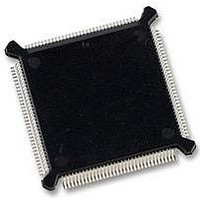MC68331CEH25 Freescale Semiconductor, MC68331CEH25 Datasheet - Page 88

MC68331CEH25
Manufacturer Part Number
MC68331CEH25
Description
IC MCU 32BIT 25MHZ 132-PQFP
Manufacturer
Freescale Semiconductor
Series
M683xxr
Specifications of MC68331CEH25
Core Processor
CPU32
Core Size
32-Bit
Speed
25MHz
Connectivity
EBI/EMI, SCI, SPI, UART/USART
Peripherals
POR, PWM, WDT
Number Of I /o
18
Program Memory Type
ROMless
Voltage - Supply (vcc/vdd)
4.5 V ~ 5.5 V
Oscillator Type
Internal
Operating Temperature
-40°C ~ 85°C
Package / Case
132-QFP
Controller Family/series
68K
No. Of I/o's
18
Cpu Speed
25MHz
No. Of Timers
1
Embedded Interface Type
QSPI, SCI, UART
No. Of Pwm Channels
2
Digital Ic Case Style
PQFP
Rohs Compliant
Yes
Processor Series
M683xx
Core
CPU32
Data Bus Width
32 bit
Data Ram Size
80 B
Interface Type
QSPI, SCI, UART
Maximum Clock Frequency
25 MHz
Number Of Programmable I/os
18
Number Of Timers
1
Maximum Operating Temperature
+ 85 C
Mounting Style
SMD/SMT
Minimum Operating Temperature
- 40 C
Eeprom Size
-
Ram Size
-
Program Memory Size
-
Data Converters
-
Lead Free Status / Rohs Status
Details
Available stocks
Company
Part Number
Manufacturer
Quantity
Price
Company:
Part Number:
MC68331CEH25
Manufacturer:
PANASONIC
Quantity:
2 000
Company:
Part Number:
MC68331CEH25
Manufacturer:
Freescale Semiconductor
Quantity:
135
Company:
Part Number:
MC68331CEH25
Manufacturer:
Freescale Semiconductor
Quantity:
10 000
4
4.7.3 Interrupt Acknowledge and Arbitration
4-46
IRQ7 is transition-sensitive as well as level-sensitive: a level-7 interrupt is not detected
unless a falling edge transition is detected on the IRQ7 line. This prevents redundant
servicing and stack overflow. A nonmaskable interrupt is generated each time IRQ7 is
asserted as well as each time the priority mask changes from %111 to a lower number
while IRQ7 is asserted.
Interrupt requests are sampled on consecutive falling edges of the system clock. In-
terrupt request input circuitry has hysteresis: to be valid, a request signal must be as-
serted for at least two consecutive clock periods. Valid requests do not cause
immediate exception processing, but are left pending. Pending requests are pro-
cessed at instruction boundaries or when exception processing of higher-priority ex-
ceptions is complete.
The CPU32 does not latch the priority of a pending interrupt request. If an interrupt
source of higher priority makes a service request while a lower priority request is pend-
ing, the higher priority request is serviced. If an interrupt request with a priority equal
to or lower than the current IP mask value is made, the CPU32 does not recognize the
occurrence of the request. If simultaneous interrupt requests of different priorities are
made, and both have a priority greater than the mask value, the CPU32 recognizes
the higher-level request.
When the CPU32 detects one or more interrupt requests of a priority higher than the
interrupt priority mask value, it places the interrupt request level on the address bus
and initiates a CPU space read cycle. The request level serves two purposes: it is de-
coded by modules or external devices that have requested interrupt service, to deter-
mine whether the current interrupt acknowledge cycle pertains to them, and it is
latched into the interrupt priority mask field in the CPU32 status register, to preclude
further interrupts of lower priority during interrupt service.
Modules or external devices that have requested interrupt service must decode the in-
terrupt priority mask value placed on the address bus during the interrupt acknowledge
cycle and respond if the priority of the service request corresponds to the mask value.
However, before modules or external devices respond, interrupt arbitration takes
place.
Arbitration is performed by means of serial contention between values stored in indi-
vidual module interrupt arbitration (IARB) fields. Each module that can make an inter-
rupt service request, including the SIM, has an IARB field in its configuration register.
IARB fields can be assigned values from %0000 to %1111. In order to implement an
arbitration scheme, each module that can initiate an interrupt service request must be
assigned a unique, non-zero IARB field value during system initialization. Arbitration
priorities range from %0001 (lowest) to %1111 (highest) — if the CPU recognizes an
interrupt service request from a source that has an IARB field value of %0000, a spu-
rious interrupt exception is processed.
Do not assign the same arbitration priority to more than one module.
When two or more IARB fields have the same nonzero value, the
Freescale Semiconductor, Inc.
For More Information On This Product,
SYSTEM INTEGRATION MODULE
Go to: www.freescale.com
WARNING
USER’S MANUAL
MC68331











